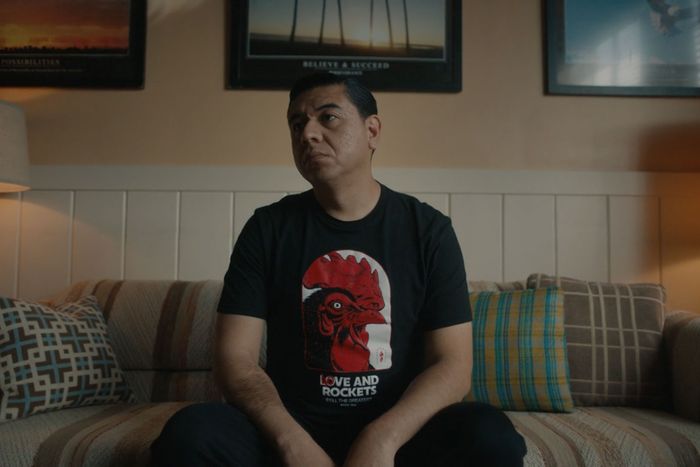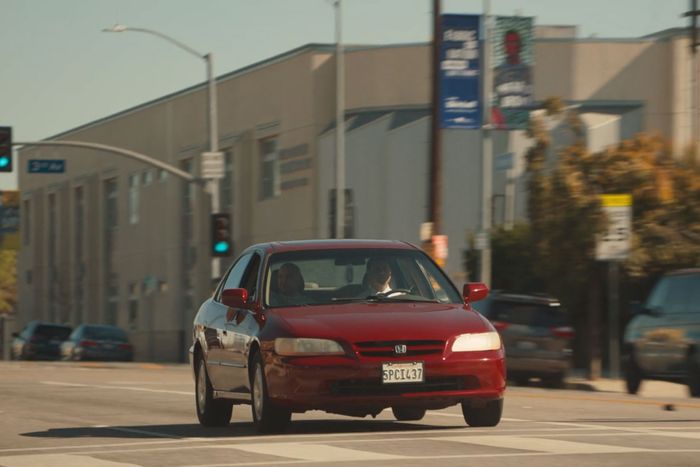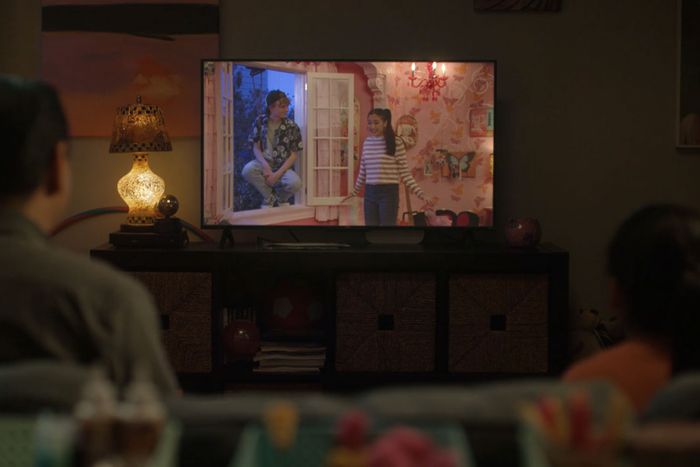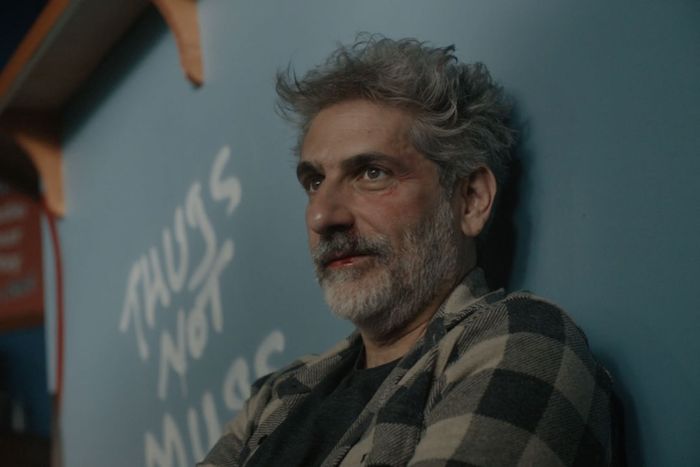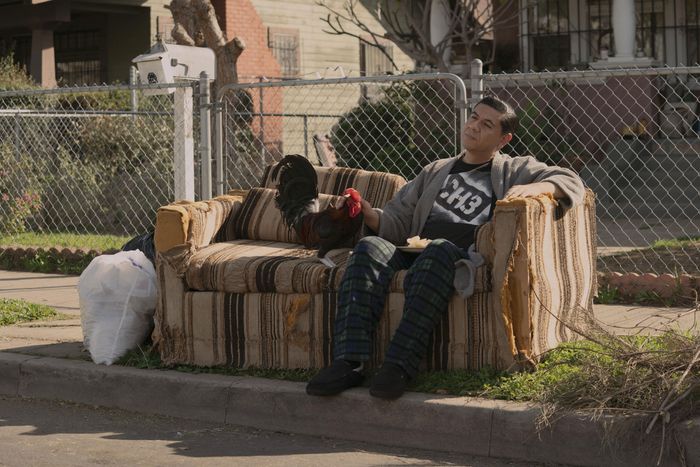
Over two seasons on Hulu, the comedy This Fool has built a vivacious and animated soundscape of Los Angeles through needle drops that bounce around decades, elevating Spanish-language musical traditions, underground genres like hardcore, and the city’s own diverse musical acts. It’s an undertaking informed by series co-creator Chris Estrada’s own tastes, which were shaped by the breadth of music he heard growing up in Los Angeles: classic hip-hop and lowrider oldies, soul and ranchera, and — most meaningfully for both Estrada and Julio, his character on This Fool — punk from around the world. Los Angeles doesn’t sound like just one thing, and Estrada wanted to use songs of all kinds to tell its story.
Estrada praises his friends and co-creators Matt Ingebretson, Pat Bishop, and Jake Weisman for the “cinematic ways” they used music in their previous show Corporate, and says they used a similar approach for This Fool. “Because this show takes place in a more urban setting like South Central Los Angeles, I think people might either expect hip-hop or Latino music,” Estrada says. “But a lot of the music on This Fool comes from us picking songs we like and making sure we don’t go the conventional route.”
To honor what Estrada describes as Los Angeles’s “eclectic” aural atmosphere, nearly every scene in This Fool has a musical element. There’s the set design and costuming, including what Julio’s younger sister calls “the stupid punk shit” in his bedroom (posters, vinyl, and art prints featuring Rage Against the Machine, Fugazi, Germs, MF DOOM, and the work of Los Angeles musician and artist Abe Garcia) and Julio’s sizable collection of band T-shirts (the Clash, Television, Fucked Up, Los Angeles punk band Channel 3, Latino hardcore group Los Crudos). There’s the diegetic music Julio, his cousin Luis (scene stealer Frankie Quiñones), and their friends and family listen to at work and at home, which Estrada tried to pack with local artists. (“Why not give groups in Southern California money instead of using a generic library track or a song from a well-known punk group that’s been played to death?”) And the dialogue brims with throwaway lines, inside jokes, and insults referencing various singers and bands, providing insight into what these characters care about and how they define themselves.
Altogether, they add significant texture to This Fool, and here Estrada explains how some of the second season’s most meaningful music moments were conceived, shot, and edited.
The Mariachi Music of Julio’s Neighborhood
Both seasons of This Fool feature a variety of Mexican, Latin American, and South American musical styles, including ranchera, banda, norteñas, and cumbia music. The season-two premiere, “The Rooster,” centers on growing neighborhood tensions over the loud rooster owned by Julio’s landlord, Don Emilio (Ramón Franco), and adopted by an aimless Julio as his companion. As the residents nearly rise against Don Emilio and his beloved fowl, Vicente Fernandez’s “Hoy Platique con Mi Gallo” blares.
We have other forms of music, banda or norteñas, but that song, which means “Today I Talked to My Rooster,” is a mariachi ranchera song. Vicente Fernández is a really famous singer from Mexico; he died two years ago. That song was brought up by Jonathan Cerda-Rowell, a Latino dude from L.A. and a really funny writer who worked on seasons one and two. I always thought we’d find a song about a rooster because in Mexican music, there’s songs about animals a lot. [Laughs.] Another song I grew up with, “Mis Tres Animales,” which means “My Three Animals,” by Los Tucanes de Tijuana, was a backup. It starts with the rooster’s crow and it’s about a man talking about how much he loves his farm animals.
The lyrics to the song that we ended up using, “Hoy Platique con Mi Gallo,” are a man apologizing to his rooster because he’s putting him into a cock fight. That song has such a crescendo, and we thought it would be very funny to have that. As much as I grew up a part of that music, I couldn’t imagine how annoyed I would be hearing someone play that at five in the morning — any music, really. I had to write a letter to Fernández’s estate or whoever owns the rights to his music publishing. They didn’t want the song to be used in a way that condones violence or drug use. I said, “I’m the creator of this show. This song is about a man who deeply cares about and is protective of his rooster. It starts racial tension in the neighborhood, but then somehow this man’s big-headedness, and his tenant’s love for this rooster — which he’s not willing to admit until the very end — bring the neighborhood together and put everybody at ease.” It almost seemed like we weren’t gonna get it. And then finally they said okay.
I wore a rooster shirt in the finale as a callback to the beginning, to bookend it. That was actually costume designer Rocio Estrada’s idea, to save that rooster shirt to the very end. Sometimes people think that’s Love and Rockets, the British band, but it’s actually America’s longest-running independent underground comic book — the band got their name from the comic book — and was started by the Hernandez brothers — Mario, Gilbert, and Jaime — in 1981, 1982. It’s about working-class life in Southern California, Latino punk-rockers, and their diverse group of friends.
Subverting Randy Newman’s “I Love L.A.”
In episode two, “Clyde & Clyde, Pt 1,” Julio and Luis go on a ride through South Central as Randy Newman’s “I Love L.A.” plays. The 1983 song’s music video follows Newman driving a convertible past recognizable signifiers of the city, including mansions and the Disneyland sign, as the lyrics shout out the Valley and Santa Monica Boulevard. Estrada wanted to show the Los Angeles where he grew up instead.
In the writers’ room, we talked about having a hostage episode and how quintessentially L.A. it is, seeing car chases on the news. As we were formulating that story, we thought, Wouldn’t it be funny if we had “I Love L.A.”? The brilliance is that it’s very tongue in cheek and almost making fun of L.A. and some of the superficialities of people who live there. We thought, Why don’t we be slightly earnest about it? We wanted to show a Los Angeles that felt more reflective of the show, parts of South Central Los Angeles, Inglewood, Compton, these neighborhoods that are working class and mostly Black and Latino, a more gritty side of L.A. that maybe tourists don’t go to. We show homeless encampments; we show neighborhoods that could use a few more resources. But it’s also an homage to a part of Los Angeles that I care about, the Los Angeles I’m most familiar with.
I made a list that was way more expansive than what we have — we were only permitted a certain mile radius. I wish we could have shot more, but I think we did good with what we had. The idea was to get street signs that go against what’s in “I Love L.A.” Let’s show Crenshaw, let’s show Western, let’s show Figaroa, let’s show Florence, let’s show Broadway. These streets are big corridors and lead through South Central Los Angeles. There was a B-roll team, and there were also scenes where Julio and Luis drive around in Julio’s red Honda. That was filmed on location with a truck following us.
Scoring Kitchen Chaos
Following the disbandment of Hugs Not Thugs at the end of season one, we meet Chef Percy at his new gig in season two, leading the pastry kitchen of a top-tier restaurant where his sous-chefs are both terrified of and aroused by him. The song used during this scene is a riff on Swedish hardcore band Refused’s “New Noise,” which is also a tension-driving musical cue on The Bear. But the song’s use here isn’t an homage to that Chicago-set series, Estrada says, just coincidence.
We wanted Chef Percy carrying on with his regimented and confrontational style from season one. In season two, we decided to show the contrast: him working in a Michelin Star–type place and judging people, being quite militaristic, almost Gordon Ramsay about it. Jamar Neighbors is so funny and such a character himself.
We tried a bunch of different songs: We tried a James Brown song, we tried a hip-hop song, we tried an electronic song. Somebody had mentioned “New Noise,” by Refused, and I was all for it. Then one of the guys didn’t want to exactly use “New Noise” because Triangle of Sadness prominently uses it. Our composer Gabriel Roland plays in a really cool band called Los Yesterdays; it’s sort of a Chicano, soul, lowrider, oldies-type band. To Gabriel, we said, “Can you do something that sounds inspired by this, something similar, without jacking it? Do your own take on it.” He delivered on that and we used that. People think we’re doing a nod to The Bear, which is a great show I enjoy, but it wasn’t. We do a lot of other nods to other things — the hostage episode was a nod to Dog Day Afternoon.
A Secret-Billionaire Singalong
After Julio and Luis get Chef Percy on board with their coffee-shop idea, they travel to the desert to enlist Minister Payne (Michael Imperioli), who has found a new family in a village of (seeming) drifters and dropouts. At a singalong that night, members of this fringe community belt out “Keep on the Sunny Side,” a 19th-century song popularized in various recordings by the Carter Family and the country group the Whites. When the villagers are later revealed as billionaires cosplaying as burnouts (“When you have everything, you vacation by pretending you have nothing,” David Arquette’s character says), Payne abandons them and returns to Los Angeles.
From the very beginning, we pitched the show as Friday directed by the Coen brothers. Some shots of Julio on the roof in season one were A Serious Man–inspired. When we were working with our music supervisor Hilary Staff, we wanted to find something folky, and she had recommended “Keep on the Sunny Side,” which was used in O Brother, Where Art Thou? We decided to use that to keep with the subtle Coen brothers influence and have an elevated surrealism.
We found that song so charming, and folky stuff often gets co-opted by the elites. It’s just so funny: They’re singing this song without irony. We like billionaires coming into the show because now, billionaires seem to play a presence in our lives constantly and more directly because of social media. They run everything, so they were always part of our lives in a way that we didn’t know about, but now they’re big spectacles. You can’t run away from the presence of the billionaire class. We thought having these people sing a song like that would be ironic and funny.
Nostalgia Knockout
Midway through the season, Julio attends a house party with friends from childhood and high school — other elder millennial and Gen X punks — and meets a new love interest: Yuli Zorrilla’s Teresa. As they flirt and banter, songs from various corners of L.A.’s diverse music scene, including ska, reggae, and a ranchera classic that makes one of Julio’s friends burst into tears, serve as diegetic music.
A lot of people in L.A. who are my age and younger, that’s the music they listen to at their house parties: punk, ska, reggae, roots reggae. That very melodic punk song in Spanish that opens the scene is by this band Ausencia, which I was a fan of. They’re from Santa Ana, which is a working class, mostly Latino neighborhood in Orange County. It’s called “Mi Lugar en Este Mundo,” which is “My Place in This World.” We later play “Love Me Forever,” by The Skatalites, which has a cool, chill vibe to it. Then there’s the song “Hasta la Miel Amarga,” by Los Tiranos del Norte, which is a ranchera song. Like most Mexican ranchera music, it’s about heartbreak. As a kid growing up, that song would always play in the background. We would all watch our uncles get drunk and cry to it.
Even though the adults at this party are first-generation Americans, if you put on this type of song, they would cry at it, too. As much as we listen to our own music that defines us, whether that’s hip-hop or punk music, your parents’ music from their home country plays a role in your life. I think that’s true for most immigrant groups. It’s background music as you try to assimilate. I’ve always liked that music, but it isn’t until you’re older that you really embrace the music of your parents. Punk music captured how I felt as an outsider, captured the anger or rage I might have had or still have. But it wasn’t until I got much older that I started looking back and going, “My parents’ music is fucking amazing.”
“If You Know, You Know”
As Julio and Teresa date, he spends time with her tween daughter, Aurora (Lydia Martinez), whose favorite show is Ashley and Jason, an exhaustingly boppy series in the Hannah Montana and Girl Meets World mold. While suffering through an episode in season two’s penultimate “Y Tu Depression Tambien,” Julio jokes about killing himself: “That show makes me wanna stab myself in the heart, Elliott Smith style.” Julio’s self-loathing is also a brief glimpse into his musical taste, and like his “I fucking hate Morrissey” line in season one, the reference isn’t elaborated upon. For fans of those artists, Estrada says, these jokes are meant to be an olive branch of understanding. Don’t blame him for the earworm theme song to Ashley and Jason, though — that was his co-creators’ doing.
Those were jokes I specifically wrote. When I was doing stand-up comedy, I tried to make sure to speak to both alternative-comedy and club-comedy audiences. If you could make both crowds laugh, that meant you were a good comic. That’s what we try to do: write a very specific show that also feels broad. My mind with the references and name drops is, If you know, you know, and that will mean something.
“Y Tu Depression Tambien,” where we reference Elliott Smith — you find Julio getting angry about this kid’s TV show. Jake and I talked about how our depression manifested as getting angry about things that did not matter. Why are you getting mad about something a child is enjoying? We thought it would be an interesting thing for this depressed guy to have an idealization of musicians that have committed suicide. Later in that same episode, when Payne sees the show, he says, “I want to blow my brains out, Kurt Cobain style,” and it’s to draw a parallel that these guys, they’re very similar and almost a bad influence on each other. The real breakup of the season is Payne and Julio, these two broken guys who found each other.
The Morrissey line came about because in L.A. and the Southwest, there’s this huge fanaticism that specifically Mexicans and other Latinos like Salvadorans have toward Morrissey. I’m not one of those fans. A lot of it was me being a bit of a contrarian. I understand that the Smiths are good music and Morrissey is good as well. But it just wasn’t my go-to. I drew a line and I said, “I’m a Cure guy.” We used to get into playful arguments because Michael Imperioli is such a Smiths and Morrissey fan. He saw them live in the ’80s and loves them. I thought it would be great to have someone say, “That guy looks like a Morrissey fan,” and for someone to say, “Fuck you, I’m not a Morrissey fan.” That really resonated with people. I got a lot of messages from Morrissey fans saying, “That made me laugh so much,” or people who aren’t Morrissey fans who said, “Thank you for saying that.” I just thought, This will mean a lot to the people in the know.
I had nothing to do with the Ashley and Jason theme song. I loved it and I was a fan of it, but one time I had to leave the writers’ room to do an interview, and when I came back, Jake, Matt, and Pat had come up with this idea of Ashley and Jason. My only idea was calling one character Lason, which I thought would mirror the Julio and Julio También thing from season one. I was with them when they were just coming up with lyrics for that song: [singing] “Ashley and Jason / Will they or won’t they / Is this child exploitation or not?” I was laughing my ass off. It was always stuck in my head.
A Series of Good-byes
Finale episode “Two Fuckin’ Losers” ends, as season one did, with breakups and fresh starts. Julio and Payne, once so united in their sadness, part ways when Julio learns that Payne purposely sabotaged their Mugs Not Thugs coffee shop for media attention. As Payne takes off for New York City — Julio’s line “This whole time I thought you didn’t go back to New York because you were in the mob or some shit” nodding to Imperioli’s iconic work on The Sopranos — Julio finally starts therapy to deal with his depression. And Luis, eager to see the world after his years in prison, takes off alone for Cambodia. The episode’s closing minutes have a melancholy feel that Estrada knew the perfect song for: El Tri’s “Las Piedras Rodantes.”
“Las Piedras Rodantes” is telling the story not just of Luis and Julio, but the story of Payne and Julio. They really are the breakup; Luis is just going on a trip. I grew up really loving that song. El Tri are a famous blues rock band from Mexico City; they’re a little bit of a Rolling Stones, Aerosmith–type band, and they’re really famous all over Latin America. That song has such a sense of nostalgia to me, and it’s very heartbreaking. Jake said, “I don’t know Spanish, and the song really touches me. There seems to be a finality to it.” We write every season like it’s the last because we don’t know whether we’re going to get another one. We ended season one with a ranchera song in Spanish, Cornelio Reyna’s “Me Caí de la Nube,” and then I thought, “Why don’t we carry that tradition of having one more Spanish-language song?”
When we started writing season two, I played the song and said, “I want this to be the last song. I think it’s a really good cap.” These guys have entered this new phase of their lives: One is going to therapy to address his issues, the other one is doing something therapeutic by traveling abroad by himself, and Payne is leaving. If we get a season three, I want him to come back. This season ending has a little bit of both resolution and cliffhanger, and we wanted to find a song that fits that kind of finality. It’s almost like two friends saying “bye” to each other.




